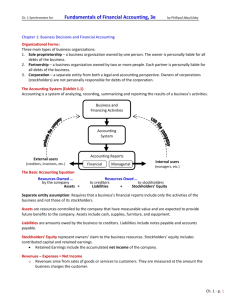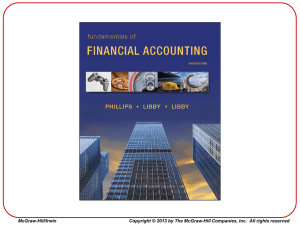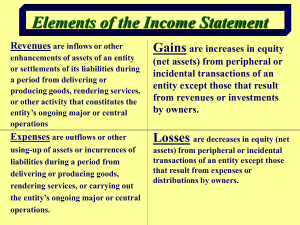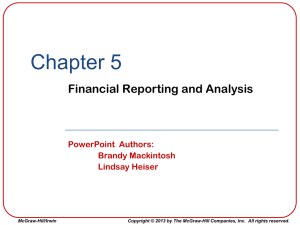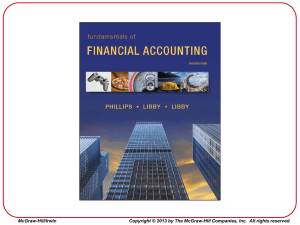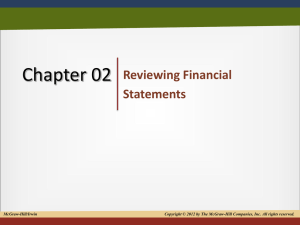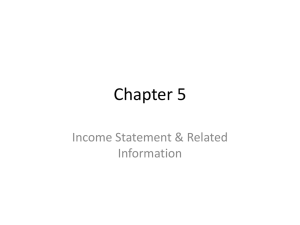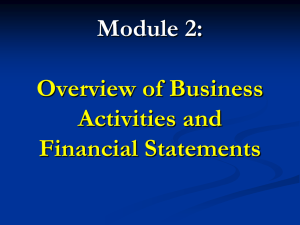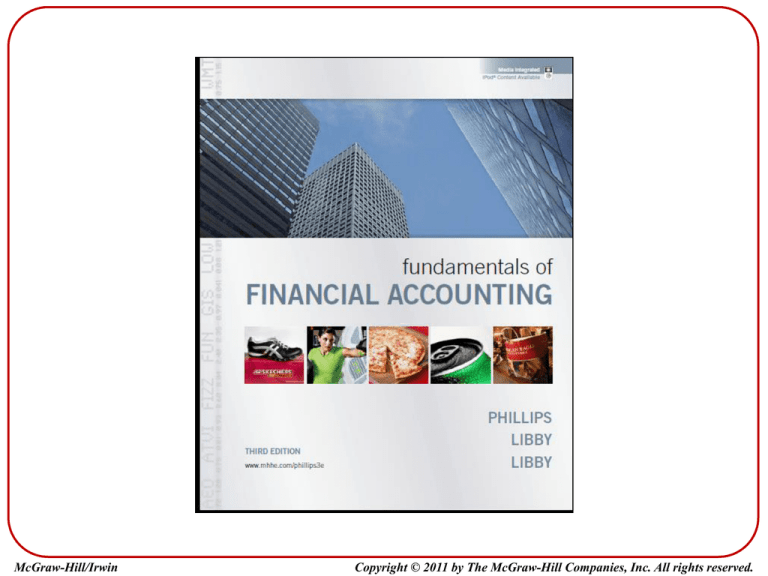
McGraw-Hill/Irwin
Copyright © 2011 by The McGraw-Hill Companies, Inc. All rights reserved.
Chapter 1
Business Decisions and Financial
Accounting
PowerPoint Authors:
Susan Coomer Galbreath, Ph.D., CPA
Charles W. Caldwell, D.B.A., CMA
Jon A. Booker, Ph.D., CPA, CIA
Fred Phillips, Ph.D., CA
Learning Objective 1
Describe various
organizational forms and
business decision makers.
1-3
Organizational Forms
Sole
Proprietorship
Business organization owned by
one person. The owner is
personally liable for all debts of
the business.
Partnership
Business organization owned by
two or more people. Each partner
is personally liable for all debts of
the business.
Corporation
1-4
A separate entity from both a legal
and accounting perspective.
Owners of corporations
(stockholders) are not personally
responsible for debts of the
corporation.
Organizational Forms
Percentage of Organizational Forms in
the U.S.
5% 3%
Sole Proprietorships
20%
Corporations
72%
Partnerships
Limited Liability
Companies
1-5
Source: BizStats.com
The Accounting System
Business and
Financing Activities
Accounting
System
Accounting Reports
External users
(creditors, investors, etc.)
Financial
Managerial
Internal users
(managers, etc.)
Accounting is a system of analyzing, recording,
summarizing and reporting the results of a
business’s activities.
1-6
Learning Objective 2
Describe the purpose,
structure, and content of the
four basic financial
statements.
1-7
The Basic Accounting Equation
Resources Owned . . .
by the company
Resources Owed . . .
to creditors
to stockholders
Assets = Liabilities + Stockholders’ Equity
Separate Entity
Assumption
Requires that a business’s
financial reports include
only the activities of the
business and not those of
its stockholders.
1-8
Assets
Resources controlled by the
company that have
measurable value and are
expected to provide future
benefits to the company.
Cash
Equipment
Supplies
1-9
Furniture
Liabilities
Amounts owed by
the business to
creditors.
Notes
Payable
1-10
Accounts
Payable
Stockholders’ Equity
Owners’ claim to the
business resources.
Contributed
Capital
Retained
Earnings
Stock Certificate
1-11
Revenues, Expenses and Net Income
Revenues – Expenses = Net Income
Revenues
Sales of goods or services
to customers. They are
measured at the
amount the business
charges the customer.
1-12
Expenses
The costs of business
necessary to earn
revenues, including
wages to employees,
advertising, insurance,
and utilities.
Dividends
Distributions of a
company’s earnings to its
stockholders as a return
on their investment.
Dividends are not an expense.
1-13
Financial Statements
Income
Statement
Statement
of Retained
Earnings
Financial
statements are
typically prepared in
this order.
Balance
Sheet
Statement
of Cash
Flows
1-14
The Income Statement
PIZZA AROMA, INC.
Income Statement
For the Month Ended September 30, 2010
Revenues
Pizza Revenue
$ 11,000
Total Revenue
11,000
Expenses
Supplies Expense
Wages Expense
Rent Expense
Utilities Expense
Insurance Expense
Advertising Expense
Income Tax Expense
Total Expenses
Net Income
1-15
$
4,000
2,000
1,500
600
300
100
500
9,000
2,000
The unit of
measurethe
Reports
assumption
amount
of
states that
revenues
results of
less
business
expenses
activities
forshould
a period
be
reported
in an
of time.
appropriate
monetary
unit.
The Statement of Retained Earnings
PIZZA AROMA, INC.
Statement of Retained Earnings
For the Month Ended September 30, 2010
Retained Earnings, Sept. 1, 2010
$
Add: Net Income
2,000
Subtract: Dividends
(1,000)
Retained Earnings, Sept. 30, 2010
$ 1,000
Reports the way that net income and the
distribution of dividends affected the financial
position of the company during the period.
1-16
The Balance Sheet
Reports at a point in time:
1. What a business owns
(assets).
2. What it owes to
creditors (liabilities).
3. What is left over for the
owners of the
company’s stock
(stockholders’ equity).
PIZZA AROMA, INC.
Balance Sheet
At September 30, 2010
Assets
Cash
Accounts Receivable
Supplies
Equipment
Total Assets
Liabilities
Accounts Payable
Notes Payable
Total Liabilities
Stockholders' Equity
Contributed Capital
Retained Earnings
Total Stockholders' Equity
Total Liabilities and Stockholders' Equity
BASIC ACCOUNTING EQUATION
Assets = Liabilities + Stockholders’ Equity
1-17
$ 14,000
1,000
3,000
40,000
$ 58,000
$
7,000
20,000
27,000
30,000
1,000
31,000
$ 58,000
The Statement of Cash Flows
PIZZA AROMA, INC.
Statement of Cash Flows
For the Month Ended September 30, 2010
Cash Flows from Operating Activities
Cash collected from customers
$
Cash paid to suppliers and employees
Cash Provided by Operating Activities
Cash Flows from Investing Activities
Cash paid to buy equipment
Cash Used in Investing Activities
Cash Flows from Financing Activities
Capital contributed by stockholders
Cash dividends paid to stockholders
Cash borrowed from the bank
Cash Provided by Financing Activities
Change in Cash
Beginning Cash Balance, Sept. 1, 2010
Ending Cash Balance, Sept. 30, 2010
$
1-18
10,000
(5,000)
5,000
(40,000)
(40,000)
30,000
(1,000)
20,000
49,000
14,000
14,000
Summarizes
how a
business’s
operating,
investing, and
financing
activities
caused its
cash balance
to change over
a particular
period of time.
Notes to the Financial Statements
Notes help financial statement users
understand how the amounts were
derived and what other information
may affect their decisions.
1-19
Relationships Among the Financial Statements
PIZZA AROMA, INC.
Income Statement
For the Month Ended September 30, 2010
Revenues
Pizza Revenue
$
11,000
Total Revenue
11,000
Expenses
Supplies Expense
Wages Expense
Rent Expense
Utilities Expense
Insurance Expense
Advertising Expense
Income Tax Expense
Total Expenses
Net Income
$
4,000
2,000
1,500
600
300
100
500
9,000
2,000
PIZZA AROMA, INC.
Statement of Retained Earnings
For the Month Ended September 30, 2010
Retained Earnings, Sept. 1, 2010
$
Add: Net Income
2,000
Subtract: Dividends
(1,000)
Retained Earnings, Sept. 30, 2010
$ 1,000
1-20
Net income
flows from the
Income
Statement to
the Statement
of Retained
Earnings.
1
Relationships Among the Financial Statements
PIZZA AROMA, INC.
Balance Sheet
At September 30, 2010
Ending Retained
Earnings flows from
the Statement of
Retained Earnings to
the Balance Sheet.
2
PIZZA AROMA, INC.
Statement of Retained Earnings
For the Month Ended September 30, 2010
Retained Earnings, Sept. 1, 2010
$
Add: Net Income
2,000
Subtract: Dividends
(1,000)
Retained Earnings, Sept. 30, 2010
$ 1,000
1-21
Assets
Cash
Accounts Receivable
Supplies
Equipment
Total Assets
Liabilities
Accounts Payable
Notes Payable
Total Liabilities
Stockholders' Equity
Contributed Capital
Retained Earnings
Total Stockholders' Equity
Total Liabilities and Stockholders' Equity
$ 14,000
1,000
3,000
40,000
$ 58,000
$
7,000
20,000
27,000
30,000
1,000
31,000
$ 58,000
Relationships Among the Financial Statements
PIZZA AROMA, INC.
Statement of Cash Flows
For the Month Ended September 30, 2010
Cash Flows from Operating Activities
Cash collected from customers
$
Cash paid to suppliers and employees
Cash Provided by Operating Activities
Cash Flows from Investing Activities
Cash paid to buy equipment
Cash Used in Investing Activities
Cash Flows from Financing Activities
Capital contributed by stockholders
Cash dividends paid to stockholders
Cash borrowed from the bank
Cash Provided by Financing Activities
Change in Cash
Beginning Cash Balance, Sept. 1, 2010
Ending Cash Balance, Sept. 30, 2010
$
PIZZA AROMA, INC.
Balance Sheet
At September 30, 2010
10,000
(5,000)
5,000
(40,000)
(40,000)
30,000
(1,000)
20,000
49,000
14,000
14,000
Assets
Cash
Accounts Receivable
Supplies
Equipment
Total Assets
Liabilities
Accounts Payable
Notes Payable
Total Liabilities
Stockholders' Equity
Contributed Capital
Retained Earnings
Total Stockholders' Equity
Total Liabilities and Stockholders' Equity
$ 14,000
1,000
3,000
40,000
$ 58,000
$
7,000
20,000
27,000
30,000
1,000
31,000
$ 58,000
Cash on the Balance Sheet and Cash at End
of Year on the Statement of Cash Flows agree.
3
1-22
Learning Objective 3
Explain how financial
statements are used by
decision makers.
1-23
Using Financial Statements
Creditors
Investors
(1)Is the company
generating enough
cash to make
payments on its
loans? … SCF
(1)What immediate
return (through
dividends) on my
contributions? … SRE
(2)Does the company
have enough
assets to cover its
liabilities? … B/S
1-24
(2)What is the longterm return (through
stock price increases
resulting from the
company’s profits)?.. I/S
Learning Objective 4
Describe factors that
contribute to useful financial
information.
1-25
External Financial Reporting
Main Goal: Provide useful financial information to
external users for decision making.
Useful
Relevant
1-26
Faithful
Faithful
Representation
Accounting Standards
1-27
World
United
States
Where?
FASB
Who?
IASB
GAAP
What?
IFRS
Ethical Conduct
When faced with an ethical dilemma:
Identify who will
benefit from the
situation and how
others will be
harmed.
Identify the
alternative courses
of action.
Choose the
alternative that is the
most ethical.
1-28
Chapter 1
Supplement
Accounting Careers
Overview of Career Choices in Accounting
Private Accounting
Public company
Private company
Nonprofit organization
Multinational
Mid-sized
Small
Public Accounting
Type of Organization
CPA firm
Size of Organization
"Big 4" (international partnerships):
Deloitte & Touche, Ernst & Young,
KPMG, PricewaterhouseCoopers
Regional
Local (partnership or proprietorship)
Auditing (assurance services)
Taxation
General accounting
Consulting such as forensic
Budgeting
(fraud) accounting, computer
Cost accounting
systems security, outsourcing,
Taxation
Functions and Specializations
bookkeeping services, and
Internal auditing
industry specialization
Others (e.g., finance, information
(e.g., high tech, banking,
systems, forecasting)
mergers and acquisitions,
and communications)
$32,000-$47,500*
$40,800-$57,500*
depending on type, size,
depending on size, geographic
Starting Salaries
geographic location, and
location, and functional area or
functional area
specialization
Chief Financial Officer (CFO),
Senior Accountant,
Controller, Treasurer,
Typical Senior Positions
Manager,
Director of Accounting
Partner
1-30
*Source: 2008 Robert Half Salary Guide. www.collegegrad.com/careers/all.shtml
Chapter 1
Solved Exercises
M1-13, E1-3, E1-6, E1-8, S1-6 (Req. 1)
M1-13 Preparing a Statement of Retained Earnings
Stone Culture Corporation was organized on January 1, 2009.
For its first two years of operations, it reported the following:
Net Income for 2009
$ 36,000
Net Income for 2010
45,000
Dividends for 2009
15,000
Dividends for 2010
20,000
Total assets at the end of 2009
125,000
Total assets at the end of 2010
242,000
On the basis of the data given, prepare a statement of retained
earnings for 2009 (its first year of operations) and 2010. Show
computations.
1-32
M1-13 Preparing a Statement of Retained Earnings
STONE CULTURE CORPORATION
Statement of Retained Earnings
For the Year Ended December 31, 2009
Retained Earnings, January 1, 2009
$
Add: Net Income
36,000
Subtract: Dividends
(15,000)
Retained Earnings, December 31, 2009
$ 21,000
STONE CULTURE CORPORATION
Statement of Retained Earnings
For the Year Ended December 31, 2010
Retained Earnings, January 1, 2010
$ 21,000
Add: Net Income
45,000
Subtract: Dividends
(20,000)
Retained Earnings, December 31, 2010
$ 46,000
1-33
E1-3 Preparing a Balance Sheet
DSW is a designer shoe warehouse, selling some of the most
luxurious and fashionable shoes at prices that people can actually
afford. Its balance sheet, at November 1, 2008, contained the
following items (in thousands).
Accounts Receivable
11,888
Cash
45,570
Contributed Capital
Notes Payable
Other Assets
Other Liabilities
291,248
99,044
494,294
79,148
Property, Plant and Equipment
233,631
Retained Earnings
179,538
Total Assets
785,383
Total Liabilities & Stockholders' Equity
?
Required:
1. Prepare the balance sheet as of November 1, solving for the
missing amount.
2. As of November 1, did most of the financing for assets come
from creditors or stockholders?
1-34
E1-3 Preparing a Balance Sheet
DSW, Inc.
Balance Sheet
At November 1, 2008
(in thousands)
Assets
Cash
Accounts Receivable
$45,570
11,888
Property, Plant, and Equipment
233,631
Other Assets
494,294
Total Assets
$785,383
Liabilities
Accounts Payable
$136,405
Notes Payable
99,044
Other Liabilities
79,148
Total Liabilities
314,597
Stockholders’ Equity
Contributed Capital
291,248
Retained Earnings
179,538
Total Stockholders’ Equity
Total Liabilities and Stockholders’ Equity
1-35
470,786
$785,383
Most of the financing
as of November 1
came from
stockholders. The
stockholders have
financed $470,786 of
the total assets and
creditors have
financed only
$314,597 of the total
assets of the
company.
E1-6 Preparing an Income Statement and Inferring Missing
Values
Regal Entertainment Group operates movie theaters and food
concession counters throughout the United States. Its income
statement for the quarter ended June 26, 2008, reported the
following amounts (in thousands):
Admissions Revenues
$
455,700
Net Income
?
Concessions Expenses
25,500
Other Expenses
233,800
Concessions Revenues
188,900
Other Revenues
31,200
Film Rental Expenses
247,000
Rent Expense
90,000
Gen. & Admin. Expenses
65,700
Total Expenses
?
Required:
1. Solve for the missing amounts and prepare an Income Statement
for the quarter ended June 26, 2008. TIP: First put the items in the
order they would appear on the Income Statement and then solve for
the missing values.
2. What is Regal’s main source of revenue and biggest expense?
1-36
E1-6 Preparing an Income Statement and Inferring Missing Values
REGAL ENTERTAINMENT GROUP
Income Statement
For the Quarter Ended June 26, 2008
(in thousands)
Revenues
Admissions Revenues
Concessions Revenues
Other Revenues
$
455,700
188,900
31,200
Total Revenues
$ 675,800
Expenses
Concessions Expenses
Film Rental Expenses
247,000
General and Administrative Expenses
65,700
Rent Expense
90,000
Other Expenses
Total Expenses
Net Income
1-37
25,500
233,800
?
662,000
?
$ 13,800
E1-6 Preparing an Income Statement and Inferring Missing Values
REGAL ENTERTAINMENT GROUP
Income Statement
For the Quarter Ended June 26, 2008
(in thousands)
Revenues
Admissions Revenues
Concessions Revenues
Other Revenues
$
455,700
188,900
31,200
Total Revenues
$ 675,800
Expenses
Concessions Expenses
Film Rental Expenses
247,000
General and Administrative Expenses
65,700
Rent Expense
90,000
Other Expenses
Total Expenses
Net Income
1-38
25,500
233,800
662,000
$ 13,800
E1-8 Inferring Values Using the Income Statement and Balance
Sheet Equations
Review the chapter explanations of the income statement and the
balance sheet equations. Apply these equations in each of the
following independent cases to compute the two missing amounts
for each case. Assume that it is the end of the first full year of
operations for the company.
TIP: First identify the numerical relations among the columns
using the balance sheet and income statement equations. Then
compute the missing amounts.
Independent
Cases
A
Total
Revenues
$
100,000 $
B
80,000
D
50,000
1-39
Net Income
(Loss)
82,000 $
80,000
C
E
Total
Expenses
$
12,000
86,000
81,000
Total Assets
Total
Liabilities
150,000 $
70,000 $
112,000
104,000
Stockholders'
Equity
60,000
26,000
13,000
22,000
77,000
(6,000)
73,000
28,000
E1-8 Inferring Values Using the Income Statement and Balance
Sheet Equations
R – E = NI
Independent
Cases
A
1-40
Total
Revenues
$
Total
Expenses
100,000 $
Net Income
(Loss)
A = L + SE
Total Assets
Total
Liabilities
Stockholders'
Equity
82,000 $
18,000 $
150,000 $
70,000 $
80,000
B
92,000
80,000
12,000
112,000
52,000
60,000
C
80,000
86,000
(6,000)
104,000
26,000
78,000
D
50,000
37,000
13,000
99,000
22,000
77,000
E
75,000
81,000
(6,000)
101,000
73,000
28,000
E1-8 Inferring Values Using the Income Statement and Balance
Sheet Equations
R – E = NI
Independent
Cases
A
1-41
Total
Revenues
$
Total
Expenses
100,000 $
Net Income
(Loss)
A = L + SE
Total Assets
Total
Liabilities
Stockholders'
Equity
82,000 $
18,000 $
150,000 $
70,000 $
80,000
B
92,000
80,000
12,000
112,000
52,000
60,000
C
80,000
86,000
(6,000)
104,000
26,000
78,000
D
50,000
37,000
13,000
99,000
22,000
77,000
E
75,000
81,000
(6,000)
101,000
73,000
28,000
S1-6 (Req. 1) Critical Thinking: Developing a Balance Sheet
On September 30, Ashley and Jason started arguing about who is
better off. Jason said he was better off because he owned a
PlayStation console that he bought last year for $350. He figures
that, if needed, he could sell it to a friend for $280. Ashley argued
that she was better off because she had $1,000 cash in her bank
account and a vintage car that she bought two years ago for $800
but could now sell for $1,400. Jason countered that Ashley still owed
$250 on her car loan and that Jason’s dad promised to buy him a
Porsche if he does really well in his accounting class. Jason said he
had $6,000 cash in his bank account right now because he just
received a $4,800 student loan. Ashley knows that Jason also owes
a tuition installment of $800 for this term.
Required:
1. Prepare a financial report that compares what Ashley and Jason
each own and owe on September 30. Make a list of any decisions
you had to make when preparing your report.
1-42
S1-6 (Req. 1) Critical Thinking: Developing a Balance Sheet
Balance Sheet
ASSETS
What is owned
Cash
Console
Car
TOTAL
What is owed
LIABILITIES
Car loan
Tuition Payable
Student Loan
TOTAL
“Net worth”
EQUITY
TOTAL
1-43
Ashley
Jason
$1,000
-0800
$1,800
$6,000
350
-0$6,350
$ 250
-0-0250
1,550
$1,800
$ -0800
4,800
5,600
750
$6,350
End of Chapter 1


